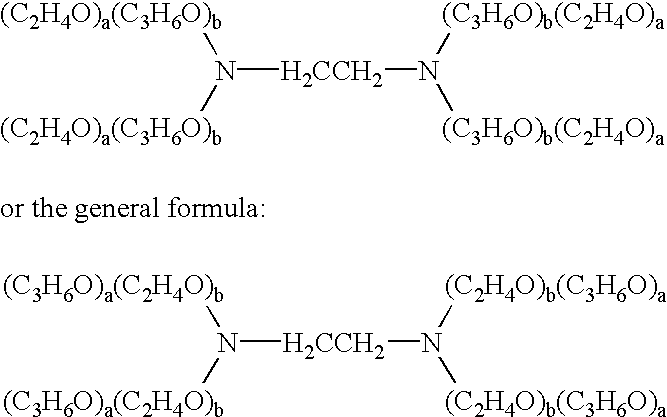Therapeutic delivery compositions and methods of use thereof
a technology of compositions and compositions, applied in the field of therapeutic delivery compounds, can solve the problems of unwanted genetic alterations, reverting back to an infectious wild-type retroviral, and inability to achieve the current approach, etc., and achieve the effect of inhibiting the replication of hiv
- Summary
- Abstract
- Description
- Claims
- Application Information
AI Technical Summary
Benefits of technology
Problems solved by technology
Method used
Image
Examples
example i
[0138] A therapeutic delivery vehicle is prepared by combining any of the surface active nonionic block copolymers, such as CRL-8131 with any of a variety of compounds capable of altering nucleic acid sequence function. For CRL-8131 a concentration of three to five percent weight per volume is desirable to construct the therapeutic vehicle. For more hydrophilic copolymer a five to ten percent weight per volume.
[0139] 300 milligrams of CRL-8131 was added to 10 ml of 0.9% NaCl and the mixture is solubilized by storage at temperatures of 2-4.degree. C. until a clear solution is formed. An appropriate amount of a compound capable of altering nucleic acid gene function is added to the mixture and micelles associating the copolymer and the compound are formed by raising the temperature above 5.degree. C. and allowing the suspension of micelles to equilibrate. The equilibrated suspension is suitable for administration.
[0140] For example, an antisense oligonucleotide sequence, such as one o...
example ii
[0143] The antiinfective antisense oligonucleotide composition of Example I is administered to HIV patients by any route effective to reduce viral activity. The preferred route of administration is by intravenous injection. The antisense composition may be administered multiple times a day to ensure that an effective amount of the antisense oligonucleotide is maintained.
example iii
[0144] A gene therapy composition for treating an animal or human suffering from the effects of a defective or missing gene is made by combining a copolymer, such as CRL-8131 with a normal copy of the defective gene. For example, for patients suffering from adenosine deaminase (ADA) deficiency a gene therapy composition is made that contains a normal copy of the adenosine deaminase gene. The gene therapy composition is made by mixing a copolymer prepared as described above in Example I with the desired gene, removing blood from the human or animal, transfecting blood cells with the ADA gene-containing composition, and reintroducing the transfected blood cells into the human or animal. The introduced gene is expressed in vivo, alleviating the effects of the original gene deficiency.
PUM
| Property | Measurement | Unit |
|---|---|---|
| molecular weight | aaaaa | aaaaa |
| molecular weight | aaaaa | aaaaa |
| mean molecular weight | aaaaa | aaaaa |
Abstract
Description
Claims
Application Information
 Login to View More
Login to View More - R&D
- Intellectual Property
- Life Sciences
- Materials
- Tech Scout
- Unparalleled Data Quality
- Higher Quality Content
- 60% Fewer Hallucinations
Browse by: Latest US Patents, China's latest patents, Technical Efficacy Thesaurus, Application Domain, Technology Topic, Popular Technical Reports.
© 2025 PatSnap. All rights reserved.Legal|Privacy policy|Modern Slavery Act Transparency Statement|Sitemap|About US| Contact US: help@patsnap.com



